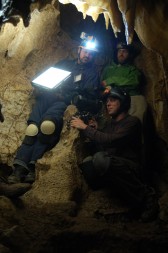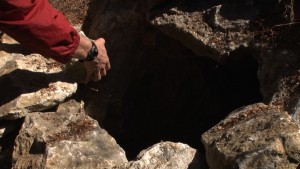Human beings have always been fascinated with caves. These clandestine spaces carved by mysterious forces elicit our natural curiosity, while at the same time the foreboding depth of their darkness creates a very visceral apprehension. Coupled with the baseline fear of earthquakes that many of us in California share, caves are often regarded with suspicion. Ironically, it is the cave that typically has more to fear from encounters with humans, and for that reason White Moon Cave and the CEMEX Redwoods Property are protected, and off limits to the public. We at KQED were fortunate enough to get a rare invitation to explore this natural wonder, and capture it on video for the very first time.

When Peninsula Open Space Trust and The Sempervirens Fund joined forces in 2011 to purchase the CEMEX Property near Davenport, CA they had no idea that White Moon Cave even existed. Their intent was to purchase the large tract of land from the Mexican cement company, as part of the Living Landscapes Initiative, in order to conserve the coast redwood groves that blanket the mountainous terrain. It was only after the purchase that they received a call from members of the Western Cave Conservancy revealing the cave’s existence, and the need to protect it.
As I twisted through the narrow entrance to the cave, I felt as if I were moving between two realms of existence. The cave air is cool, laden with moisture; the air inside exudes an earthy perfume, both familiar and strange but pleasant; the enveloping sense of stillness grows into something profound; time seems to move slower, insulated from the light and sound of daily life. One of the most powerful ways to experience this exquisite isolation is to find a corner, sit down, and turn off all of the lights. It takes a few minutes, but soon the darkness and quiet wash over you. Deprived, the senses become magnified. Even the sound of a single drop of water falling onto the sandy cave floor resolves in crisp detail.

Moving through the cave could be very challenging. The cave floor varied from slippery wet rock to fine dry silt that clung to every piece of clothing. The unforgiving marble walls seemed to reach out to bite at my shoulders and knees, and the ceiling seemed to creep just below where I expected I to be, making my helmet more than a mere precaution.
Solution caves like this one are created when rainwater is absorbed by the soil. Microbes in the soil produce carbon dioxide (CO2) and as the water percolates through the soil it becomes acidified, creating a weak carbonic acid (H2CO3). This slightly acidic water makes its way down to the limestone where the carbonic acid slowly dissolves the calcium carbonate in the marble. The dissolved limestone is said to be “in solution.”